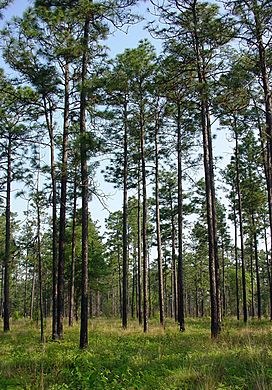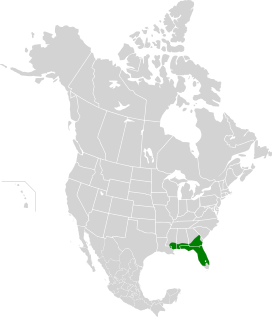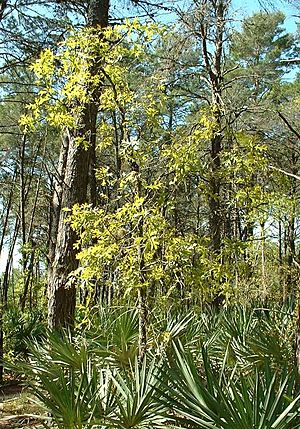Southeastern conifer forests facts for kids
Quick facts for kids Southeastern conifer forests |
|
|---|---|

Longleaf pine savanna
|
|
 |
|
| Ecology | |
| Realm | Nearctic |
| Biome | Temperate coniferous forests |
| Borders |
List
|
| Bird species | 236 |
| Mammal species | 54 |
| Geography | |
| Area | 236,725 km2 (91,400 sq mi) |
| Country | United States |
| States | Louisiana, Mississippi, Alabama, Georgia and Florida |
| Conservation | |
| Global 200 | Yes |
| Habitat loss | 30.291% |
| Protected | 13.47% |
Imagine a huge forest in the southeastern United States filled with tall, cone-bearing trees! This is the Southeastern Conifer Forests ecoregion. It's the biggest forest of its kind east of the Mississippi River. An ecoregion is like a special natural area with its own unique plants and animals.
Contents
- Climate in the Southeastern Conifer Forests
- Plants of the Southeastern Conifer Forests
- Upland Longleaf Pine Woodlands
- Longleaf Pine Sandhills
- Near-Coast Pine Flatwoods
- Nonriverine Cypress Domes
- Oak Domes and Hammocks
- Hydric Hammocks
- Maritime Forests
- Dry Upland Hardwood Forests
- Mesic Slope Forests
- Dry and Dry-Mesic Oak Forests
- Highlands Freshwater Marshes
- Nonriverine Basin Swamps
- Blackwater River Floodplain Forests
- Animals of the Southeastern Conifer Forests
- Protecting Natural Habitats
Climate in the Southeastern Conifer Forests
This amazing forest has a humid subtropical climate. This means it's usually warm and humid. It also gets a lot of rain all year long, which helps all the plants grow!
Plants of the Southeastern Conifer Forests
Long ago, these forests were mostly open woodlands. They were filled with tall longleaf pine trees. The ground below was covered in wiregrass. You can also find pine savannas and flatwoods here. Some areas even have dry (or xeric) hardwood forests.
Upland Longleaf Pine Woodlands
These woodlands are mostly made up of longleaf pine trees. They need frequent fires to stay healthy. These fires clear out other plants and help the pines grow.
The soils here drain water very well. You might see scrub oaks like turkey oak and bluejack oak growing under the pines. The ground is often covered with wiregrass.
Longleaf Pine Sandhills
Florida longleaf pine sandhills are found on sandy hills in Florida. They are also full of longleaf pine trees. Just like the upland woodlands, these areas need frequent fires.
Turkey oak is a common tree in the lower parts of these forests. Wiregrass covers the ground here too.
Near-Coast Pine Flatwoods
These forests are found on wide, sandy flatlands near the northern Gulf of Mexico. The main trees are longleaf pine or slash pine.
Fires happen naturally here every one to four years. The plants growing under the trees can be grassy or bushy. This depends on how often fires occur. You might see shrubs like swamp titi and gallberry.
Nonriverine Cypress Domes
These are small wetlands that look like domes. The trees in the middle are taller, and they get shorter towards the edges. They grow in wet, low areas surrounded by pine flatwoods.
Pond cypress trees are common here. You might also see swamp tupelo and sweetgum trees.
Oak Domes and Hammocks
These are thick groups of evergreen oak trees. They grow in small patches on low spots or small hills. These oak forests are different from the pine forests around them.
In wetter spots, you'll find southern live oak and sand laurel oak. Drier spots have sand live oak and longleaf pine.
Hydric Hammocks
These forests are found in flat, low areas of the coastal plain. They often grow over limestone. These forests have evergreen and deciduous hardwood trees. They are usually near rivers that have a steady flow of water.
You might see trees like Atlantic white cedar and elm. Cabbage palm is also common.
Maritime Forests
Along the Gulf Coast, maritime forests grow on barrier islands. They are found in sheltered spots behind coastal dunes. These forests have a mix of pine trees and broad-leaved evergreen trees.
Common trees include sand pine, slash pine, and longleaf pine. You'll also see southern live oak and cabbage palm. Strong winds and salt from the ocean can make these trees look shaped and pruned.
Dry Upland Hardwood Forests
These forests have many different kinds of oak trees. They also have mixed evergreen trees. Pine trees can be found here too. These forests are usually in places protected from fires.
Sand laurel oak is a common oak. Other trees include post oak and southern red oak. You might also see loblolly pine.
Mesic Slope Forests
These forests grow on steep slopes and ravines. Fires are rare here. They have special plants not found in other local forests. These include American beech and southern magnolia.
In the northern parts, you'll find more trees that lose their leaves in the fall.
Dry and Dry-Mesic Oak Forests
These forests are mostly made up of oaks and hickories. They are protected from fires by hills or by the types of plants growing there.
Common trees include white oak and mockernut hickory.
Highlands Freshwater Marshes
These are wetlands found in shallow valleys or dried-up lake beds. They have many different kinds of plants. The plants vary depending on how deep the water is.
Deep water has plants that float or are fully underwater. Shallower areas have tall, grassy plants. These include bulrush and American lotus.
Nonriverine Basin Swamps
These swamps are found in large, low areas that flood with water during certain seasons. They are not near rivers. Trees like bald cypress and swamp tupelo grow here.
You might also see evergreen shrubs. Slash pine can sometimes be found too.
Blackwater River Floodplain Forests
These forests grow along blackwater rivers and streams. These rivers get their dark color from decaying plants. Common trees include bald cypress and water tupelo. Atlantic white cedar also grows here.
Animals of the Southeastern Conifer Forests
The old longleaf pine forests are very important homes for some special animals. These include the red-cockaded woodpecker, which is a vulnerable bird. The gopher tortoise, a type of turtle, also lives here.
Protecting Natural Habitats
Sadly, most of the old longleaf pine forests are gone today. Only a few small areas still have their natural habitat. In many places, these forests have been replaced with slash pine farms. These farms are not as diverse as the natural forests.
Many places are working to protect these special forests. Here are some of them:
- Bogue Chitto National Wildlife Refuge
- De Soto National Forest
- Conecuh National Forest
- Blackwater River State Forest
- Point Washington State Forest
- Deer Lake State Park
- Torreya State Park
- St. Joseph Peninsula State Park
- St. Vincent National Wildlife Refuge
- St. George Island State Park
- St. Andrews State Park
- Bald Point State Park
- Tate's Hell State Forest
- Apalachicola National Forest
- Gulf Islands National Seashore
- Mississippi Sandhill Crane National Wildlife Refuge
- Grand Bay National Wildlife Refuge
- Edward Ball Wakulla Springs State Park
- Wakulla State Forest
- St. Marks National Wildlife Refuge
- Okefenokee Swamp
- Suwannee River State Park
- Osceola National Forest
- Cumberland Island National Seashore
- Jennings State Forest
- Paynes Prairie
- Ocala National Forest
- Lake Woodruff National Wildlife Refuge
- Tiger Bay State Forest
- St. Johns National Wildlife Refuge
- Cedar Keys National Wildlife Refuge
- Myakka River State Park
- Kissimmee Prairie Preserve State Park
- Withlacoochee State Forest
- Chassahowitzka National Wildlife Refuge
- Goethe State Forest
- Waccasassa Bay Preserve State Park
- San Felasco Hammock Preserve State Park
- Lake Talquin State Forest
- Three Rivers State Park
- Mike Roess Gold Head Branch State Park
- Florida Caverns State Park



